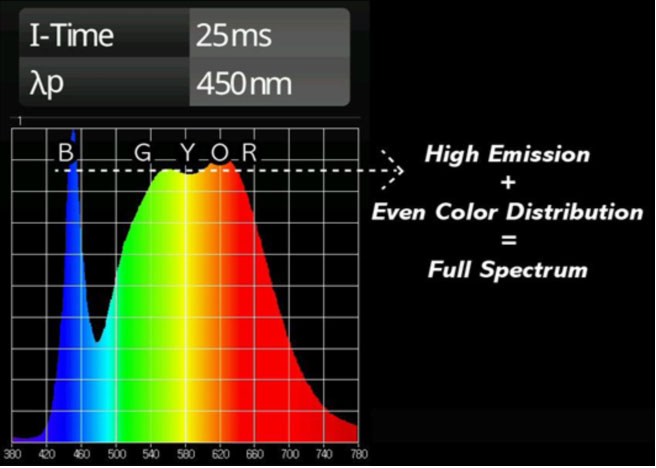Full Spectrum Growlight- What & Why
Growook full spectrum LED grow lights are designed to mimic natural outdoor sunlight to help your plants grow healthier and yield better harvests with quality and intensity of light they are accustomed to from natural sunlight.

Natural Sunlight includes all spectrums, even beyond what we can see with the naked eye such as ultraviolet and infrared. Traditional HPS lights put out an intense high band of limited nanometer wavelengths (yellow light), which activates photorespiration which is why they have been so successful in agricultural applications up to today. LED grow lights that provide only two, three, four, or even eight colors will never come close to reproducing the effects of sunlight. With so many different LED spectrums on the market it gets concerning for a large farm with a variety of species whether or not that LED grow light is right for them; with Growook LED No matter what species or genetic you grow under our light, it will succeed without having to second guess the spectral output. Why change what Mother Nature has already perfected over millions of years?
Growook full spectrum LED grow lights consistently emit wavelengths in the range of 380 to 779nm. This includes those wavelengths visible to the human eye (what we perceive as color) and the invisible wavelengths, like ultraviolet and infrared.
We know that blue and red are the wavelengths that dominate “active photosynthesis” .So you might think that providing these colors alone might circumvent the rules of nature. However, there is a problem: productive plants, whether they’re on a farm or in nature, need photorespiration. When plants become heated by intense yellow light like HPS or natural sunlight, the stomata on the leaf surfaces open up to allow for photorespiration. During photorespiration, the plants go into “workout” mode, which causes them to consume more nutrients just like humans want to drink water or eat after a session at the gym. This translates into growth and a healthier harvest.
The Benefits of Full Spectrum Light for Plants
Traditional LED arrays tend to only emit the spectrums that activate after the photorespiration period takes place (grow lights with dominant red and blue LEDs). This is the reason traditional LED lights sometimes finish cycles with immature plants that produce low yields. By supplying plants with only the limited “beneficial” spectrums (pink light) from traditional LED arrays, you are essentially putting them into a permanent chill mode. You may end up with some healthy plants, but they will not yield as much or be as healthy as plants under a full spectrum LED grow light. If red and blue light were truly all that plants needed then why do HPS lights which don’t have much of either color outperform them? The answer is intensity which plants go for first then spectrum. When you give your plants both intensity and full spectrum light they will pay you back every time.